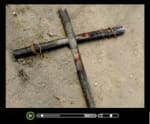Crucifixion
Crucifixion: Jesus Faced a Horrible Death
Crucifixion sometimes began with a scourging or flogging of the victim’s back. The Romans used a whip called a flagrum, which consisted of small pieces of bone and metal attached to a number of leather strands. The number of blows given to Jesus is not recorded; however, the number of blows in Jewish law was 39 (one less than the 40 called for in the Torah, to prevent a counting error). During the scourging, the skin was ripped from the back, exposing a bloody mass of tissue and bone. Extreme blood loss occurred, often causing death, or at least unconsciousness. In addition to the flogging, Jesus faced severe beating and torment by the Roman soldiers, including the plucking of His beard and the piercing of His scalp with a crown of thorns.
After the flogging, the victim was often forced to carry his own crossbar, or patibulum, to the execution site. The patibulum could easily weigh 100 pounds. In the case of Jesus, the record shows that He may have carried His patibulum the distance of over two football fields. In a weak and tormented state, it’s no wonder the record establishes that Jesus needed a great deal of assistance. Once the victim arrived at the execution site, the patibulum was put on the ground and the victim was forced to lie upon it. Spikes about 7 inches long and 3/8 of an inch in diameter were driven into the wrists. The spikes would hit the area of the median nerve, causing shocks of pain up the arms to the shoulders and neck. Already standing at the crucifixion site would be the 7-foot-tall post, called a stipes. In the center of the stipes was a crude seat to “support” for the victim. The patibulum was then lifted on to the stipes, and the victim’s body was awkwardly turned on the seat so that the feet could be nailed to the stipes. At this point, there was tremendous strain put on the wrists, arms and shoulders, resulting in a dislocation of the shoulder and elbow joints. The position of the nailed body held the victim’s rib cage in a fixed position, which made it extremely difficult to exhale, and impossible to take a full breath. Having suffered from the scourging, the beatings and the walk with the patibulum, Jesus was described as extremely weak and dehydrated. He was probably losing significant amounts of blood. As time passed, the loss of blood and lack of oxygen would cause severe cramps, spasmodic contractions and probably unconsciousness.
Ultimately, the mechanism of death in crucifixion was suffocation. To breathe, the victim was forced to push up on his feet to allow for inflation of the lungs. As the body weakened and pain in the feet and legs became unbearable, the victim was forced to trade breathing for pain and exhaustion. Eventually, the victim would succumb in this way, becoming utterly exhausted or lapsing into unconsciousness so that he could no longer lift his body off the stipes and inflate his lungs. Due to the shallow breathing, the victim’s lungs would begin to collapse in areas, probably causing hypoxia. Due to the loss of blood from the scourging, the victim probably formed a respiratory acidosis, resulting in an increased strain on the heart, which beats faster to compensate. Fluid would also build up in the lungs. Under the stress of hypoxia and acidosis, the heart would eventually fail. There are several different theories on the actual cause of death for Jesus. One theory is that there was a filling of the pericardium with fluid, which put a fatal strain on the ability of His heart to pump blood. Another theory states that Jesus died of cardiac rupture. Another theory is that Jesus' death was “multifactorial and related primarily to hypovolemic shock, exhaustion asphyxia and perhaps acute heart failure.” Regardless of the actual medical cause of final death, the historical record is very clear -- Jesus suffered numerous hours of horrible and sustained torture on the cross of Calvary.
Crucifixion: Jesus Suffered for You and Me
The crucifixion accounts of Jesus Christ are in entire agreement with the customs and practices of the Romans in that period. The evidence for Christ’s horrible and painful death is unquestioned by today’s legitimate scholars. The only dispute is the nature and character of the “criminal” Jesus Christ. Look at the record yourself -- Even with all the pain, Jesus thought of others rather than Himself. His first words from the cross were, "Father, forgive them; for they know not what they do" (Luke 23:34). He thought of His mother, who stood by the cross weeping, and asked his beloved disciple John to take care of her. On either side of Jesus were two thieves executed at the same time. When one of them accepted Jesus as Lord, Jesus shared with him, "To day shalt thou be with Me in paradise" (Luke 23:43). Finally, Jesus expressed his complete surrender to the will of God as He said, "It is finished;" (John 19:30). "Father, into Thy hands I commend My spirit" (Luke 23:46). Investigate the historical record, and then examine your heart. Jesus gave Himself willingly for you and me. Jesus suffered a horrible death for you and me. Jesus loved us so much that He willingly died in utter shame and pain for our sins. In fact, the Bible teaches us that He who was without sin was literally "made sin" for us. God, in human form, allowed himself to be made sin to save us. On the cross, he bore all the world's sin because of His love. The only way to complete His story of love is to love Him in return.
What is your response?



